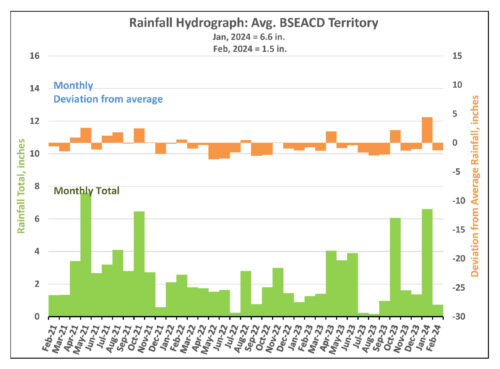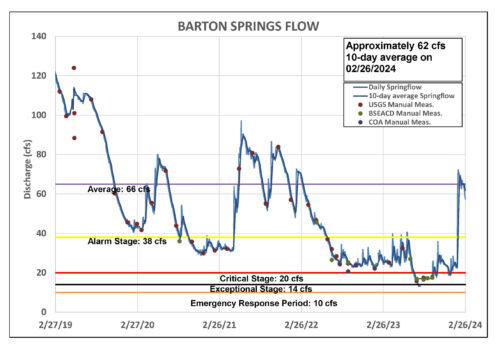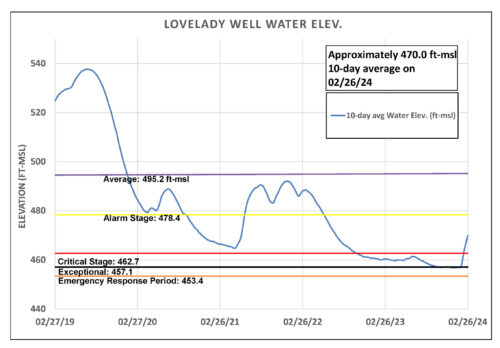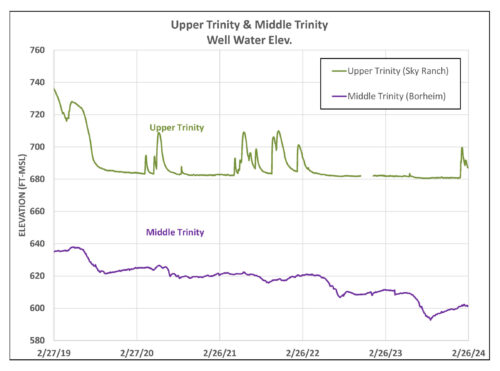Transition to Stage II Alarm Drought
Ongoing Impact of Early 2024 Rainfall
In January the District received an average of 6 inches of rain. This rain increased flow in the Blanco River and creeks throughout the area. District monitor wells and spring flow gauges recorded increases in water levels for both the Edwards and Trinity aquifers. During the February 8 Board Meeting, the District transitioned from Stage IV Exceptional Drought (declared on December 14, 2023) to Stage III Critical Drought.
The area received another 1.5 inches of rain in February, which augmented aquifer recharge and further increased both groundwater levels and spring flow.
Moving Up to Stage II Alarm Drought
The District will declare Stage II Alarm Drought on Friday, March 1, 2024, which will be effective immediately. This will be the first time the District will be above the Stage III drought level since October 2022.
This transition is a result of the Lovelady monitor well, one of two drought trigger determinants, reaching a 10-day average above 462.7 feet-mean sea level (ft-msl). Lovelady groundwater levels continue to increase as a result of the early 2024 rains. All permittees will be contacted directly by the District with additional information.
The District urges community members, in and outside of our territory, to continue to conserve water resources since the Edwards and Trinity aquifers are still recovering from the last two years of drought. For additional information, please visit the District’s Drought Information and Resources page.
Rainfall
Typically, February stands out as the driest month of the year in the Austin area. This month, the District has received an average of 1.5 inches, which is 0.4 inches below the area’s average (figure 1). The near-average rainfall in December, coupled with the fifth wettest January on record, has significantly improved our drought status.

Figure 1. Monthly deviation from average and monthly total rainfall in District’s territory.
Groundwater Levels and Spring Flow
Barton Springs Flow
Extensive rainfall in January and additional rain in February had an immediate effect on spring flow. Barton Springs discharge increased from 23 cubic feet per second (cfs) on January 22 to a peak of 73 cfs on January 26 (figure 2). As of February 26, the 10-day average spring flow was 62 cfs. Although this exceeds the spring flow threshold indicated of Stage II Alarm Drought, the water levels in the Lovelady monitor well still fall within Stage II. This is why the District will remain in drought.
Starting on February 24, the pool will be closed for its annual spring clean from February 24 to March 8. During this time the USGS real-time gauge will also undergo maintenance and may not report data.

Figure 2. Barton Springs flow for the last five years.
Lovelady Monitor Well
The groundwater levels of the Lovelady monitor well have continued to increase as a result of the early 2024 rainfall. Since January 20 groundwater levels, which were as low as 456.8 feet-mean sea level (ft-msl), have climbed to 470.0 as of February 26 (figure 3). The ongoing elevation in groundwater levels is attributed to the continued flow in creeks, which allows water to enter recharge features like fractures, sinkholes, and caves. Given the significant rise in groundwater levels at Lovelady the District will declare Stage II Alarm Drought on Friday, March 1. This is triggered by Lovelady levels surpassing 462.7 ft-msl.
Figure 3. Lovelady groundwater level over the last five years.
Upper and Middle Trinity
Water levels in the Upper Trinty (green) showed a strong response to the January rains, witnessing a significant increase of 20 feet (figure 4). However, levels are currently receding from that peak. In contrast, the Middle Trinity (purple) has displayed a more subdued yet positive response to the rains, maintaining a relative holding pattern.
The flow at Jacob’s Well is consistently reporting around 2 cfs, while the Blanco River at Wimberley maintains a steady flow in the high teens.
Figure 4. Water levels in an Upper Trinity well (green) and Middle Trinity well (purple) over the last five years.
Forecast and Conservation
The latest Drought Outlook from the Climate Prediction Center and the U.S. Drought Monitor point toward some improvement of drought severity for parts of the area, but not a complete transition out of drought from February through April.
Meteorological spring extends from March 1 to May 31, and Climate Prediction Center’s spring outlook shows an equal chance for above or below average temperatures and precipitation. A transition from El Niño to ENSO-neutral is likely by April-June 2024, with increasing odds of La Niña developing in June-August 2024.
Drought development is also likely for western and southern Texas, where antecedent conditions are already dry and the seasonal precipitation outlook favors below-average precipitation.
The District urges community members in and outside of our territory to continue to conserve water resources since the Edwards and Trinity aquifers are still recovering from the last two years of drought. Please visit our Water Conservation Tips page for more information and resources.
Feature image by Matthew Guthrie



